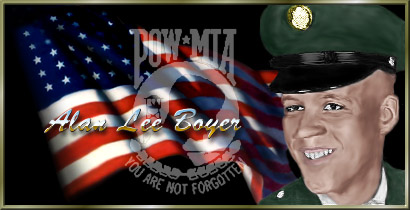
Rank/Branch: Sergeant First Class/US Army
Unit: C & C Detachment, Drawer 22 (MACV-SOG)
5th Special Forces Group,
1st Special Forces
Date of Birth: 08 March 1946
Home of Record: Missoula, MT
Date of Loss: 28 March 1968
Country of Loss: Laos
Loss Coordinates: 164730N 1062000E (XD434574)
Status in 1973: Missing In Action
Category: 4
Aircraft/Vehicle/Ground: Ground
Other Personnel in Incident: Charles Huston and George R. Brown (missing)
REMARKS: SYNOPSIS: MACV-SOG, or Military Assistance Command Vietnam Studies
and Observation Group, was a joint service high command unconventional
warfare task force engaged in highly classified operations throughout
Southeast Asia. The 5th Special Forces channeled personnel into MACV-SOG
(though it was not a Special Forces group) through Special Operations
Augmentation (SOA), which provided their "cover" while under secret orders to
MACV-SOG. These teams performed deep penetration missions of strategic
reconnaissance and interdiction that were called, depending on the timeframe,
"Shining Brass" or "Prairie Fire" missions. On 28 March 1968, SFC George
Brown, intelligence specialist; then Sgt. Alan Boyer, rifleman; Sgt."Greg"
Huston, rifleman; and 8 South Vietnamese (ARVN) troops were inserted into the
rugged jungle covered mountains of eastern Laos to conduct a reconnaissance
patrol in an area well known for its heavy enemy activity. Further, this area
of eastern Laos was known to contain major and minor arteries of the infamous
Ho Chi Minh Trail. When North Vietnam began to increase its military strength
in South Vietnam, NVA and Viet Cong troops again intruded on neutral Laos for
sanctuary, as the Viet Minh had done during the war with the French some
years before. This border road was used by the Communists to transport
weapons, supplies and troops from North Vietnam into South Vietnam, and was
frequently no more than a path cut through the jungle covered mountains. US
forces used all assets available to them to stop this flow of men and
supplies from moving south into the war zone. As the patrol moved through
dense jungle just south of a secondary road and approximately 7 miles
north-northwest of the city of Tchepone, 14 miles west of the Lao/South
Vietnamese border and 33 miles northwest of Khe Sanh, South Vietnam; it made
contact with an enemy force of unknown size. When it became apparent they
were outnumbered and outgunned, the team requested an immediate extraction by
helicopter. They also took evasive action to escape and evade toward a
designated rendezvous point. When the extraction helicopter arrived on
station, its crew dropped a rope ladder through the dense jungle to the
reconnaissance team. Seven of the ARVN soldiers safely climbed up the ladder
to the hovering aircraft. As the 8th allied soldier climbed aboard, it came
under heavy enemy automatic weapons fire. Simultaneously, Sgt. Boyer began to
climb the ladder. Seconds later, as the helicopter began to depart under
fire, the ladder caught in the foliage and broke. Alan Boyer fell the short
distance back to the ground. When last seen by the helicopter crew and ARVN
soldiers during the extraction attempt, all 3 Americans were alive, uninjured
and successfully defending their position. Three days later, on 1 April, a
search and rescue (SAR) team was inserted into the ambush site to search for
the three Americans. This ground search continued for 6 hours in and around
the last known position of the three Americans, but failed to locate any
evidence of the men either alive or dead. At the time formal search efforts
were terminated, Alan Boyer, Greg Huston and George Brown were listed Missing
in Action. For every insertion like this one that was detected and stopped,
dozens of others safely slipped past NVA lines to strike a wide range of
targets and collect vital information. The number of MACV-SOG missions
conducted with Special Forces reconnaissance teams into Laos and Cambodia was
452 in 1969. It was the most sustained American campaign of raiding, sabotage
and intelligence gathering waged on foreign soil in US military history.
MACV-SOG's teams earned a global reputation as one of the most combat
effective deep-penetration forces ever raised. Alan Boyer, Greg Huston and
George Brown are among nearly 600 Americans who disappeared in Laos. Many of
these men were known to be alive on the ground. The Laotians admitted holding
"tens of tens" of American Prisoners of War, but these men were never
negotiated for either by direct negotiation between our countries or through
the Paris Peace Accords which ended the War in Vietnam since Laos was not a
party to that agreement. Since the end of the Vietnam War, over 21,000
reports of American prisoners, missing and otherwise unaccounted for have
been received by our government. Many of these reports document LIVE American
Prisoners of War remaining captive throughout Southeast Asia TODAY. Military
personnel in Vietnam were called upon to undertake many dangerous missions,
and they were prepared to be wounded, killed, or captured. It probably never
occurred to them that they could be abandoned by the country they so proudly
served.